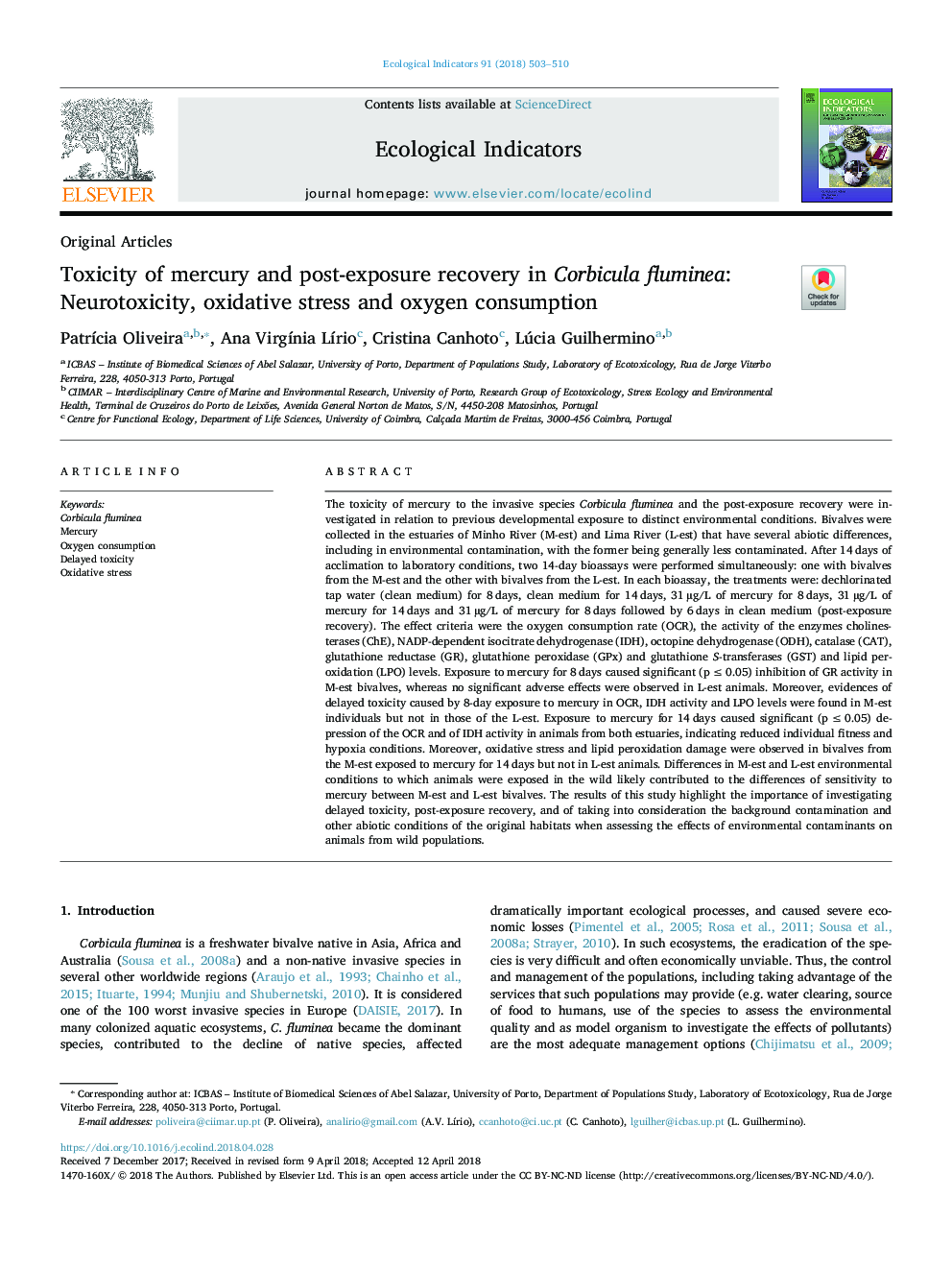| کد مقاله | کد نشریه | سال انتشار | مقاله انگلیسی | نسخه تمام متن |
|---|---|---|---|---|
| 8845364 | 1617111 | 2018 | 8 صفحه PDF | دانلود رایگان |
عنوان انگلیسی مقاله ISI
Toxicity of mercury and post-exposure recovery in Corbicula fluminea: Neurotoxicity, oxidative stress and oxygen consumption
دانلود مقاله + سفارش ترجمه
دانلود مقاله ISI انگلیسی
رایگان برای ایرانیان
کلمات کلیدی
موضوعات مرتبط
علوم زیستی و بیوفناوری
علوم کشاورزی و بیولوژیک
بوم شناسی، تکامل، رفتار و سامانه شناسی
پیش نمایش صفحه اول مقاله

چکیده انگلیسی
The toxicity of mercury to the invasive species Corbicula fluminea and the post-exposure recovery were investigated in relation to previous developmental exposure to distinct environmental conditions. Bivalves were collected in the estuaries of Minho River (M-est) and Lima River (L-est) that have several abiotic differences, including in environmental contamination, with the former being generally less contaminated. After 14â¯days of acclimation to laboratory conditions, two 14-day bioassays were performed simultaneously: one with bivalves from the M-est and the other with bivalves from the L-est. In each bioassay, the treatments were: dechlorinated tap water (clean medium) for 8â¯days, clean medium for 14â¯days, 31â¯Âµg/L of mercury for 8â¯days, 31â¯Âµg/L of mercury for 14â¯days and 31â¯Âµg/L of mercury for 8â¯days followed by 6â¯days in clean medium (post-exposure recovery). The effect criteria were the oxygen consumption rate (OCR), the activity of the enzymes cholinesterases (ChE), NADP-dependent isocitrate dehydrogenase (IDH), octopine dehydrogenase (ODH), catalase (CAT), glutathione reductase (GR), glutathione peroxidase (GPx) and glutathione S-transferases (GST) and lipid peroxidation (LPO) levels. Exposure to mercury for 8â¯days caused significant (pâ¯â¤â¯0.05) inhibition of GR activity in M-est bivalves, whereas no significant adverse effects were observed in L-est animals. Moreover, evidences of delayed toxicity caused by 8-day exposure to mercury in OCR, IDH activity and LPO levels were found in M-est individuals but not in those of the L-est. Exposure to mercury for 14â¯days caused significant (pâ¯â¤â¯0.05) depression of the OCR and of IDH activity in animals from both estuaries, indicating reduced individual fitness and hypoxia conditions. Moreover, oxidative stress and lipid peroxidation damage were observed in bivalves from the M-est exposed to mercury for 14â¯days but not in L-est animals. Differences in M-est and L-est environmental conditions to which animals were exposed in the wild likely contributed to the differences of sensitivity to mercury between M-est and L-est bivalves. The results of this study highlight the importance of investigating delayed toxicity, post-exposure recovery, and of taking into consideration the background contamination and other abiotic conditions of the original habitats when assessing the effects of environmental contaminants on animals from wild populations.
ناشر
Database: Elsevier - ScienceDirect (ساینس دایرکت)
Journal: Ecological Indicators - Volume 91, August 2018, Pages 503-510
Journal: Ecological Indicators - Volume 91, August 2018, Pages 503-510
نویسندگان
PatrÃcia Oliveira, Ana VirgÃnia LÃrio, Cristina Canhoto, Lúcia Guilhermino,